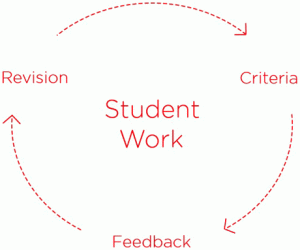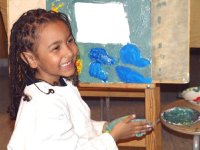Learning to Work and Think Like an Artist
The Creative Learning Loop teaches artistic thinking by fostering student inquiry and providing experience through clear criteria, peer feedback, and opportunities for revision.
Your content has been saved!
Go to My Saved Content.The artists and staff at ArtsConnection have engaged in inquiries for well over a decade into the nature of teaching and learning in the arts and their influence on other areas of learning. Most of our practitioner research has focused on dance, theater, and their influence on literacy and language acquisition, especially among English-language learners.
Inquiry and Experience
We have identified two ways that learning in the arts has a profound influence on language development:
1. It is inquiry based. The artistic process is one of exploration and making artistic choices that require using imagination and higher-order thinking skills.
2. It is experiential and kinesthetic, which makes learning memorable.
While authentic arts education experiences incorporate embodied cognition, the purpose of teaching and learning in the arts is to help students learn to work and think like artists.
Our colleagues Jessica Nicoll and Barry Oreck -- who are dancers, researchers, and educators -- describe working and thinking like artists as "learning to pose meaningful questions, discover interests and pursue provocative problems, and work collaboratively in the unknown territory of artistic creation." So how do children learn to work and think like artists?
Artistic creation in all art forms is an iterative process: collaboration, critique, and revision are essential especially in the performing arts. Formative assessment is intrinsic to artistic creation in all art forms: making artistic choices, giving and receiving feedback, and revision. This fundamental of teaching and learning made visible in the arts is key to the procedural knowledge essential to student achievement of the Common Core State Standards.
In the Loop
The artists and staff at ArtsConnection have articulated a process that has been useful across disciplines: The Creative Learning Loop, a feedback loop that helps students improve their work in the arts.

1. Establish Clear Criteria
First, provide opportunities for students to observe and describe artistic work before peer feedback begins. Help them use specific language to describe the artistic choices that made the work "successful" or effective at communicating an idea or feeling. Then use this student-generated language in an assignment for small-group work, where students have the opportunity to make their own artistic choices and share their work-in-progress with other students.
2. Facilitate Peer Feedback
First, develop two things with students: a protocol and sentence starters. We use protocols adapted from the Making Learning Visible work at Harvard’s Project Zero and David Perkins' Ladder of Feedback. Always begin with compliments, i.e., describe what is strong in the work. Then offer suggestions that -- from the point of view of the audience -- would help the work communicate the idea or feeling even more effectively. Again, language use ("I wish. . ." or "Maybe you could. . .") lets the performers know that they are in charge and that they own their artistic process.
3. Provide Opportunities for Revision
Give students time to reconsider their choices, make changes, and rehearse before sharing their work again. It is most useful for student learning if their time to revise immediately follows the feedback process.
Creative Learning in Action
These steps are deceptively simple and, like all good teaching, require practice. The rewards for both students and teaching artists, however, have proved well worth the investment of time. You can check out a variety of examples on the Creative Learning Loop in action by teaching artists. And you can find an in-depth example of an entire dance residency at The Earth School in New York City with links to videos including interviews with students and teachers.
In the comments section below, please tell us about the successes of your school's art program and how you think it might be improved.
